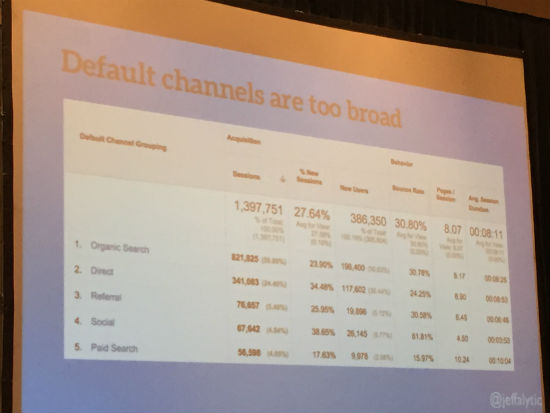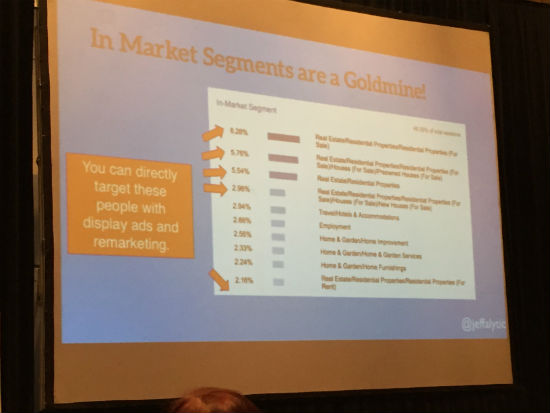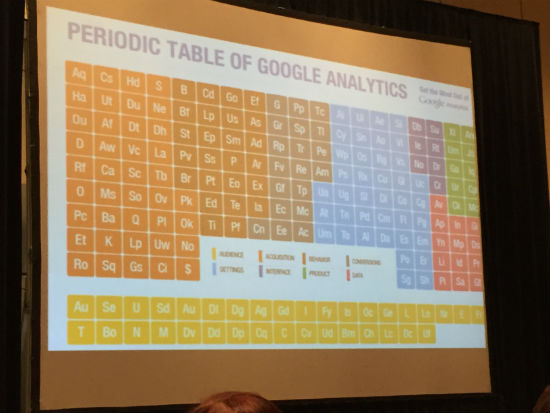
Google Analytics is used by more than 10 million websites, but the majority of digital marketers and businesses are merely scratching the surface of what this powerful free tool can do. As Jeff Sauer says, “any report that is one click away in Google Analytics isn’t worth your time”.
In his fascinating and super actionable presentation at MNSearch Summit 2015, Jeff shared some great tips to help marketers get more value from Google Analytics.

Customize Your Content and Channel Groupings
Out of the box, Google Analytics comes with a default set of traffic channels, including organic search, referral, direct, paid, social and email. While technically these are inclusive of the range of sources which may drive traffic to your site, there is opportunity to break up these broad swaths of visitors into customized segments that are specific to your business by creating customized channel groupings. Doing this can help you efficiently track the performance of your site for visitors that really matter, your customers and prospects.
A few custom channel groupings to consider are:
• Guest posted content referral traffic: tracks referral traffic from domains where you contribute content
• Branded organic search traffic: traffic from search engines to pages on your site which are well optimized for branded keywords (e.g. your about pages)
• Non-branded organic search traffic: traffic from search engines to pages which target non-branded terms (i.e. blog or resource pages)
• Logged in vs. logged out users
• Traffic from a specific target geographic area
Benchmark Against Your Competitors
Did you know that Google Analytics has a built in feature that allows you to benchmark and compare your performance against competitors in your industry category? If you said no, you’re not alone, as the majority of GA users don’t use this feature either. That’s a mistake, because understanding more about your competition is the key to winning in the digital marketplace.
While the data you can glean about your competitors isn’t nearly as comprehensive as what you can see for your own site (probably a good thing), it can provide the extra insights that can help you to more effectively compete in your industry space.

Enable Demographics Reporting
Curious to see how your site is performing for a particular age range or gender? Google Analytics can give you these answers in the demographics report if you have it enabled.
The demographics report is another un-utilized feature of Google Analytics, likely because it requires a bit of additional setup in order to start seeing data, but the steps aren’t complicated.
Once you have the demographics report enabled and are seeing some data, make sure you put it to good use. A few tips to get you started with demographics data are:
• Review the demographics of your converting visitors to better understand the makeup of your best potential customers.
• Identify which content is the most and least popular with your target demographics.
• Use demographic data in your display and remarketing campaigns.
Clean Up Your Data
Many people tend to treat data from Google Analytics as gospel, but the truth is that metrics that come from GA (or any web analytics platform) will always be approximate. There are many things that cause inaccuracies in Google Analytics reports, such as encrypted browsers, data sampling, blocked cookies or tracking implementation errors.
In recent years, another insidious “dirty data” factor has reared its head, known as referral spam. Caused by malicious spammers that exploit the open nature of the Google Analytics API to inject fake data into webmasters GA accounts, referral spam can cause inflated traffic metrics. It’s easy enough to spot by reviewing your referral traffic report and looking for visits sent from domains like trafficmonetize.com, webmonetizer.net or 100dollars-seo.com.
While there isn’t a perfect solution to the referral spam issue, at the moment the best course of action is to filter spam domains from your GA profile to prevent them from showing up in your traffic reports and skewing metrics.
Unfortunately it’s impossible to have a perfectly clean data set, but taking actions to clean up your data as much as possible can greatly increase its value, which ultimately leads to better business insights.

Tell a Story with Your Data
We’re living in the midst of a veritable web analytics renaissance, with digital marketers having the ability to freely access a vast array of data that was inconceivable to marketers a few decades ago.
However, while data is plentiful, unfortunately meaningful analysis is still scarce, which means that many marketers and businesses are failing to effectively take advantage of web analytics to drive business decisions. Worse still, many have convinced themselves that they are data driven by creating mammoth dashboards stuffed with surface level metrics that lack any real analysis.
In order for data to be valuable, it needs to tell a story. “Traffic is up 50% over last month” doesn’t say much, but “referral traffic from the ebook campaign we launched last month helped to drive a 50% increase in total website traffic, 20% increase in soft leads and 10% increase in revenue compared to the previous month” tells a much more compelling story.
A good web analytics story not only summarizes the current situation, it leads to actionable next steps. Taking the example above, a logical and actionable next step would be to allocate additional budget to the content marketing team to concept and launch additional ebook campaigns.
That’s the kind of story that drives business decisions and leads to results, and that’s what all digital marketers should be striving for from their web analytics.
Looking for Jeff’s Presentation?
You can view Jeff’s entire #MNSummit presentation below:
Need help getting started or elevating your company’s analytics?
The team at TopRank Online Marketing offers a full range of web analytics services to help businesses large and small to get the most from their data.


